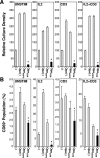Neisserial outer membrane vesicles bind the coinhibitory receptor carcinoembryonic antigen-related cellular adhesion molecule 1 and suppress CD4+ T lymphocyte function
- PMID: 17620353
- PMCID: PMC1951172
- DOI: 10.1128/IAI.00222-07
Neisserial outer membrane vesicles bind the coinhibitory receptor carcinoembryonic antigen-related cellular adhesion molecule 1 and suppress CD4+ T lymphocyte function
Abstract
Pathogenic Neisseria bacteria naturally liberate outer membrane "blebs," which are presumed to contribute to pathology, and the detergent-extracted outer membrane vesicles (OMVs) from Neisseria meningitidis are currently employed as meningococcal vaccines in humans. While the composition of these vesicles reflects the bacteria from which they are derived, the functions of many of their constituent proteins remain unexplored. The neisserial colony opacity-associated Opa proteins function as adhesins, the majority of which mediate bacterial attachment to human carcinoembryonic antigen-related cellular adhesion molecules (CEACAMs). Herein, we demonstrate that the Opa proteins within OMV preparations retain the capacity to bind the immunoreceptor tyrosine-based inhibitory motif-containing coinhibitory receptor CEACAM1. When CD4(+) T lymphocytes were exposed to OMVs from Opa-expressing bacteria, their activation and proliferation in response to a variety of stimuli were effectively halted. This potent immunosuppressive effect suggests that localized infection will generate a "zone of inhibition" resulting from the diffusion of membrane blebs into the surrounding tissues. Moreover, it demonstrates that OMV-based vaccines must be developed from strains that lack CEACAM1-binding Opa variants.
Figures



References
-
- Aase, A., L. M. Naess, R. H. Sandin, T. K. Herstad, F. Oftung, J. Holst, I. L. Haugen, E. A. Hoiby, and T. E. Michaelsen. 2003. Comparison of functional immune responses in humans after intranasal and intramuscular immunisations with outer membrane vesicle vaccines against group B meningococcal disease. Vaccine 21:2042-2051. - PubMed
-
- Achtman, M., M. Neibert, B. A. Crowe, W. Strittmatter, B. Kusecek, E. Weyse, M. J. Walsh, B. Slawig, G. Morelli, A. Moll, and M. Blake. 1988. Purification and characterization of eight class 5 outer membrane protein variants from a clone of Neisseria meningitidis serogroup A. J. Exp. Med. 168:507-525. - PMC - PubMed
-
- Bhat, K. S., C. P. Gibbs, O. Barrera, S. G. Morrison, F. Jahnig, A. Stern, E. M. Kupsch, T. F. Meyer, and J. Swanson. 1991. The opacity proteins of Neisseria gonorrhoeae strain MS11 are encoded by a family of 11 complete genes. Mol. Microbiol. 5:1889-1901. (Erratum, 6:1073-1076.) - PubMed
-
- Bjune, G., E. A. Hoiby, J. K. Gronnesby, O. Arnesen, J. H. Fredriksen, A. Halstensen, E. Holten, A. K. Lindbak, H. Nokleby, and E. Rosenqvist. 1991. Effect of outer membrane vesicle vaccine against group B meningococcal disease in Norway. Lancet 338:1093-1096. - PubMed
-
- Boulton, I. C., and S. D. Gray-Owen. 2002. Neisserial binding to CEACAM1 arrests the activation and proliferation of CD4+ T lymphocytes. Nat. Immunol. 3:229-236. - PubMed
Publication types
MeSH terms
Substances
LinkOut - more resources
Full Text Sources
Other Literature Sources
Research Materials
Miscellaneous

